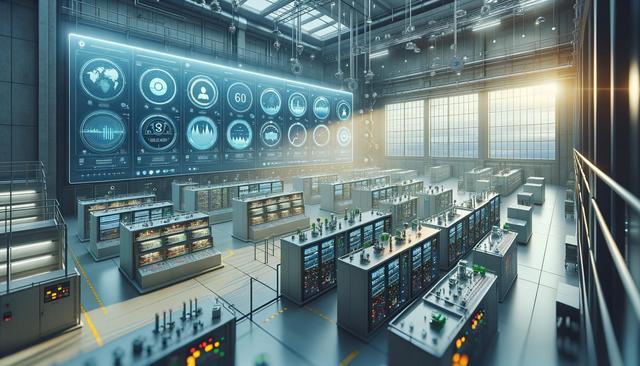Understanding the Role of Facility Monitoring Systems
Facility Monitoring Systems: Real-Time Oversight for Critical Operations play a pivotal role in maintaining the integrity and functionality of mission-critical environments. These systems are designed to provide intuitive, constant tracking of environmental and security parameters, allowing organizations to prevent disruptions before they escalate into operational failures. Real-time data collection supports rapid decision-making and ensures that compliance standards are consistently met. Whether deployed in healthcare settings, data centers, or manufacturing plants, the accuracy and responsiveness of monitoring tools are vital for minimizing risks associated with temperature fluctuations, humidity imbalances, or unauthorized access.
The core functionality of these systems lies in their ability to integrate with existing infrastructure, enabling centralized oversight. A well-implemented system continuously gathers data, which is then analyzed against predefined thresholds. If any parameter deviates beyond acceptable limits, the system can trigger alerts, initiate automated responses, or notify personnel for immediate action. This real-time responsiveness is essential for environments where even minor deviations can lead to significant consequences, such as spoilage of medical supplies or equipment malfunctions.
Key Components and Capabilities
Facility Monitoring Systems: Real-Time Oversight for Critical Operations are composed of several integrated components that work together to ensure comprehensive monitoring. These typically include sensors, data loggers, monitoring software, and communication modules. Each element plays a specific role in capturing and transmitting data for analysis and reporting. Modern systems often feature cloud-based dashboards, making critical data accessible from remote locations and supporting multi-site oversight.
Key capabilities often include:
- Temperature and humidity monitoring for climate-sensitive operations
- Access control and surveillance for enhanced security
- Automated alert systems through email, SMS, or app notifications
- Data logging and reporting for audits and compliance
These capabilities allow organizations to not only track current conditions but also identify trends and predict potential issues. For example, a gradual rise in room temperature in a server room can be addressed proactively before it causes hardware damage. Similarly, a humidity spike in a pharmaceutical storage area can be corrected to prevent contamination or product loss.
Applications Across Industries
The versatility of Facility Monitoring Systems: Real-Time Oversight for Critical Operations makes them applicable across a wide range of industries. In healthcare, they are used to monitor the storage conditions of vaccines and medications, ensuring efficacy and compliance with regulatory standards. In manufacturing, they help maintain optimal environmental conditions for production quality and equipment longevity. Data centers rely heavily on these systems to protect sensitive hardware and prevent costly downtime.
Other areas where these systems prove essential include:
- Food and beverage storage facilities
- Biotech and pharmaceutical laboratories
- Logistics and cold chain operations
- Research institutions and academic labs
Each of these environments has specific monitoring needs, but all benefit from the same core advantages — enhanced safety, improved efficiency, and reduced operational risk. The ability to tailor system configurations to industry-specific requirements adds to their widespread adoption.
Benefits of Real-Time Monitoring
Implementing Facility Monitoring Systems: Real-Time Oversight for Critical Operations offers a range of operational and strategic benefits. The most immediate advantage is the ability to act instantly on environmental or security alerts, minimizing downtime and preventing damage. This responsiveness not only protects assets and personnel but also ensures continuity of operations, which is essential in high-stakes environments.
Additional benefits include:
- Improved regulatory compliance through accurate data logging and reporting
- Reduced manual oversight, allowing personnel to focus on core tasks
- Increased lifespan of equipment and infrastructure
- Energy efficiency through optimized environmental control
Moreover, the data collected over time can be invaluable for process improvement and audit readiness. By analyzing historical trends, organizations can identify inefficiencies, predict equipment maintenance needs, and make informed decisions on infrastructure upgrades. These insights are particularly useful for long-term planning and resource allocation.
Implementation and Maintenance Considerations
While the advantages of Facility Monitoring Systems: Real-Time Oversight for Critical Operations are clear, successful implementation requires careful planning. The first step is to assess the specific monitoring needs of the facility and identify the environmental and security parameters that must be controlled. Selecting compatible hardware and software is critical, as is ensuring that the system can scale with operational growth.
Key considerations include:
- System compatibility with existing infrastructure
- Ease of integration and user training
- Reliability and uptime of monitoring equipment
- Data storage and backup solutions
Regular maintenance and system testing are also essential to ensure ongoing reliability. Calibration of sensors, software updates, and network security checks should be part of a routine maintenance schedule. Many providers offer support services to assist with these tasks, helping organizations keep their monitoring systems effective and up to date.
Conclusion: Enhancing Operational Confidence
Facility Monitoring Systems: Real-Time Oversight for Critical Operations are an essential investment for organizations that manage sensitive environments and critical processes. These systems provide the tools needed to maintain safety, ensure compliance, and respond swiftly to potential issues. By integrating real-time monitoring into their operational strategy, businesses can gain peace of mind, knowing they have the oversight necessary to keep their facilities secure and efficient. For decision-makers seeking to enhance operational resilience, adopting a robust facility monitoring system is a step toward smarter, data-driven facility management.




Leave a Reply